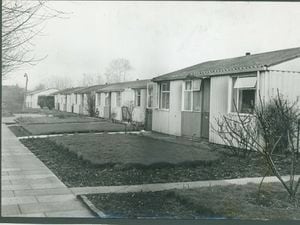'Temporary' prefab homes that were built in wartime and lasted for decades
The imminent demolition of prefabricated homes that have come to house a tight-knit community in Bushbury stirs memories of such houses' origins.

The prefabs in Bushbury, which are set to be demolished to the heartbreak of residents, are typical of the many temporary homes built at the end of the Second World War, as central and local government looked at ways to tackle the desperate housing shortage.
The war had played havoc with Britain's housing stock. While Wolverhampton largely escaped the worst the Luftwaffe had to offer, about 200,000 houses across the country were wiped out by air-raids.
The war effort had also left Britain with an acute shortage of skilled labour, while conventional building materials were in short supply.
The problem was identified as early as 1942, when Churchill created the cross-party Burt Committee. A team of engineers was sent to the US to see how the Americans were using prefabricated building techniques to tackle its own shortage.
In March, 1944, with the enemy in retreat, Churchill used a radio broadcast to announce the Emergency Factory Made programme, which would see the Ministry of Works build 500,000 ‘new-technology’ prefabricated temporary houses at the end of the war.
Churchill said: "The emergency programme is to be treated as a military evolution handled by the Government with private industry harnessed in its service.
"As much thought will go into the prefabricated housing programme as went to the invasion of Africa."
While Britain's postwar governments failed to meet the ambitious targets set during the closing stages of the war, they did succeed in building more than 150,000 prefabs over a four-year period, which were typically designed to remain in use for 10-15 years.
This was not the first time prefabricated houses had been built in Britain. As early as 1925, two pairs of cast-iron semis were erected in the Brewery Fields of Dudley, one of which has since been preserved at the Black Country Living Museum. But it was not until after the Second World War that the idea truly caught on.
In Wolverhampton, chairman of housing Councillor Ted Lane announced the construction of more than 400 new homes, and it was estimated that prefabricated construction methods could reduce the amount of on-site labour by 50-80 per cent.
The first prefabs began to spring up on the East Park Estate, off Willenhall Road South, and at Bushbury, in March 1945, with all 400 temporary homes complete by November 23 the following year.
Of those, 293 of these were built by Hull-based Tarran Industries, while a further 107 were of an American design.
The Tarran bungalows had a floor area of 655 sq ft, including a shed, and had a 150 sq ft living room, two bedrooms, plus a separate WC. Bathroom units and kitchen cupboards were made from steel.
The American-design was broadly similar, but had a slightly smaller second bedroom, and the timber-framed walls were covered with asbestos sheeting.
Most of the prefabs in East Park were demolished about 10 years ago, and it seems the Bushbury ones are likely to be dealt a similar fate.
However, a smaller development of bungalows built by the former Tettenhall Council in Henwood Road, Compton, survives to this day, with the external walls now rebuilt in brick.





